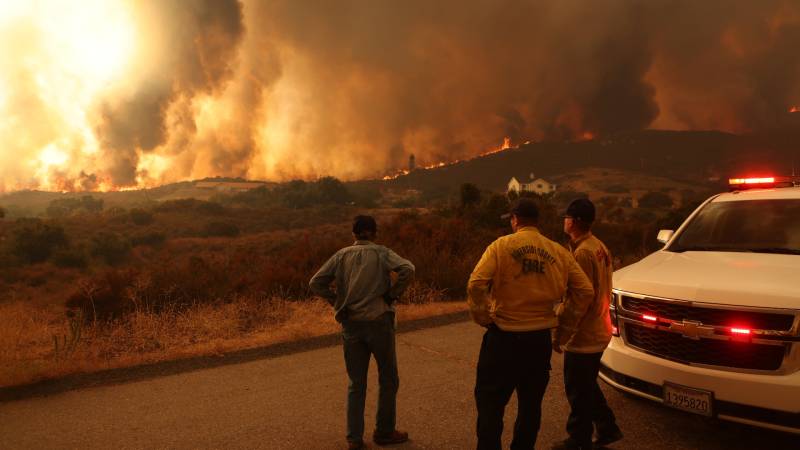Joan Casey, Associate Professor of Environmental and Occupational Health Sciences, University of Washington
Interview Highlights
Southern California Wildfires Overview
For more than a week, Southern California has been besieged by three fires in the San Gabriel and San Bernardino mountains and parts of Orange and Riverside counties. But favorable weather conditions are helping firefighters gain ground in the Airport Fire, the Line Fire and the Bridge Fire. The fires grew quickly due to dry conditions, steep terrain and increasing winds. Madison Aument, a KVCR reporter who covered the Line and Bridge Fires, noted that “the skies were brown. You couldn’t see the mountains for a few days. It was dark outside. It was hard to breathe for a lot of people.”
Suspected Arson and Recent Fire Trends
On Sept. 17, a 28-year-old former FedEx driver from Norco pleaded not guilty to charges of starting the Line Fire, which authorities suspect was arson. Nick Schuler, CALFIRE’s deputy director of communications and incident awareness, highlighted CalFire’s increased focus on fire prevention and crackdown on arsonists. “As part of CalFire and other agencies’ heavy focus on fire prevention efforts since 2016, we’ve arrested more than 800 arsonists in California from our agency alone,” Schuler said.
Southern California could see more fires as Santa Ana winds arrive. Schuler said that CALFIRE “recognizes that in Southern California, Santa Ana winds essentially push wind-driven fires from east to west, which is a significant threat.” Overgrown vegetation in the region exacerbates that threat, he added.
Health Impacts of Wildfire Smoke
More research is emerging on the health effects of wildfire smoke, particularly fine particulate matter known as PM 2.5. As Joan Casey, associate professor of environmental and occupational health sciences at the University of Washington, explained, “When these fine particles are inhaled, they can get deep into the lungs, into the bloodstream, leading to inflammation, oxidative stress, possibly DNA damage.”
Amy MacPherson of the California Air Resources Board added that wildfire smoke can cause immediate issues like eye irritation, coughing, and exacerbation of heart and lung diseases. Prolonged exposure raises risks of premature death.
Casey discussed her study linking long-term wildfire PM 2.5 exposure to increased dementia risk of developing dementia. The findings surprised researchers, as wildfire pollution appeared more harmful than other PM 2.5 sources.
Other potential impacts discussed included adverse mental health outcomes from stress, evacuation trauma, and pollution inhalation. Casey noted more research is needed on firefighters and outdoor workers facing disproportionate smoke exposure.
Protecting Against Smoke Exposure Indoors and Outside
MacPherson shared tips for creating a cleaner air space within homes during smoke events, such as identifying a room that can be sealed off, using portable air cleaners or a DIY box fan with HEPA filters, and avoiding activities that produce indoor particulates like smoking, vacuuming, or burning candles. She also recommended regular filter replacement and avoiding the use of whole-house fans or swamp coolers, which can introduce outdoor smoke.
For those going outside, MacPherson advised wearing a properly fitted N95 or P95 mask approved by the National Institute for Occupational Safety and Health. “Those masks are going to filter out up to 95% of that small particulate matter, but they’re only effective if fitted and worn appropriately,” MacPherson said
California communities are establishing clean air centers – permanent facilities or temporary spaces opened during fires – where people can seek refuge from smoke. More information – and a map of the centers – can be found on CARB’s website.
Finally, MacPherson recommended EPA’s AirNow app and CARB’s California Smoke Spotter app for monitoring local air quality.
This content was edited by the Forum production team but was generated with the help of AI.
California Clean Air Centers Map
Smoke Ready California
